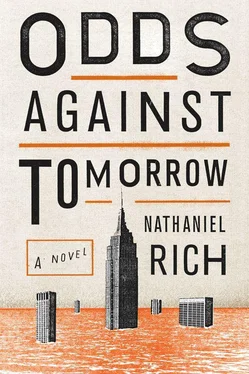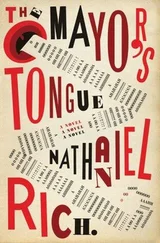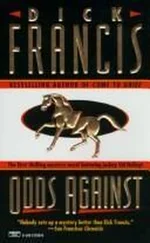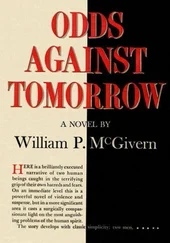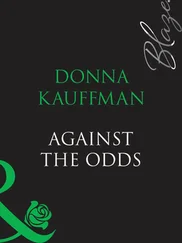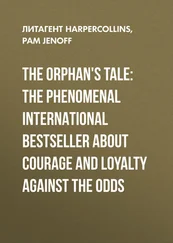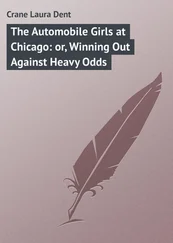Mitchell glanced around the room, avoiding eye contact with Tanizaki. He had their attention. There was the white-knuckled concentration he had grown accustomed to in his months at FutureWorld, the dry mouths and anxious, tapping fingers. For him these subtle signals were like the roar of applause. He took a deep breath, then continued.
“But what are the odds, really, of this happening? I mean, it’s one thing for a Category Four hurricane to hit the East Coast. But in order to create the kind of worst-case scenario I’ve outlined, the hurricane would have to follow an extremely specific course. It would have to make landfall east of Atlantic City and then continue on a north-northwest path into the New York Bight, with the eye of the storm passing within fifteen miles of Staten Island. And the odds of that, despite the latest trajectory analyses, remain fairly low.”
“How low?” asked D’Espy. She leaned forward; her expression had softened.
“I haven’t done all the math yet. But I’d estimate odds of less than one in eight. There’s a high probability of some damage regardless, of course, but nothing worse than the 1992 storm.” He smiled uneasily.
“Oh,” said D’Espy. “Is that so?”
“Yes,” continued Mitchell. “I think we’ll all be OK. Soon everything will be back to normal.” He tilted backward slightly, and for balance he grabbed the edge of the table, his fingers smudging the glass.
“Mitchell,” said Tanizaki. “Are you all right?”
If he could only get the most recent numbers out of the National Hurricane Center, he’d be able to determine the odds precisely. Was it really one in eight? Might it be higher? The truth was that he had invented the figure. Twelve point five percent seemed a safe, low number. It was a hunch — no more, no less. The calculations were vague because the data was vague. He needed better numbers. When could he get better numbers?
“Bring the boy some water,” said Ms. D’Espy. The others around the table muttered and ruffled their papers.
The first thing he’d do, once he got the new figures from the National Hurricane Center, was calculate the odds of the storm maintaining its Category 2 status. He’d have to cross tab those odds against the storm’s range of potential trajectories. A graph would help. The x-axis would represent the distance from the center of the New York Bight at which the storm would pass; the y-axis would represent the strength of the hurricane, measured by the Saffir-Simpson scale. At x = 0 and y = Category 5, the storm would be at its most powerful, and it would make a direct hit on New York harbor—
“I don’t think he’s telling us the truth,” said D’Espy. “Mitchell? Do you hear me talking to you?”
At the right end of the x-axis, mark one thousand miles. Set the y-axis between Category 1 and 5. Plot each data point with a hash mark. Connect the points. What would the line look like? What kind of shape would form? Would it be a Poisson distribution? A parabola? A sine curve? Or would it be pure chaos, the marks like drops of water in a rainstorm? Any hash mark that landed near the point of origin would represent variations on the worst-case scenario — high probability of major impact, high Saffir-Simpson rating. High casualties. High chaos. Out rushes Cerberus, barking with all his heads—
Rough material abraded the back of Mitchell’s neck. He was annoyed to discover that it was carpet pile. Someone pressed a cold, damp paper towel to his forehead. A large drop of water leaked down the side of his face and trickled into his ear. Water seemed always to be trickling down his face — first in the high-rise on Spruce Street, then in the rainstorm, and now. What the hell did it mean?
“Mitchell? Are you OK?”
He looked into a reassuring, smoothly contoured face, a face like a well-made bed.
“Jason?”
“You gave us quite a scare.” The others had gathered behind Tanizaki in a circle around Mitchell’s body. “Give him air,” said Tanizaki.
Once the others backed away Tanizaki removed the compress. “You especially scared Ms. D’Espy,” he said in a confidential, prideful tone. His voice softened to a whisper. “I think you scared yourself.”
* * *
The rest of the day proceeded much the same way, minus the fainting spell. The rain intensified slightly. It collected in pools that eddied by the sewer gutters, conveying trash from every alley and garbage can into the avenues. The breaking reports about the hurricane grew increasingly dire — now it was veering straight at New York, now the gusts were as high as 130 miles per hour, a robust Category 3—and Mitchell had to work harder in order to convince himself that the worst could be avoided. This put him in an unusual position with clients. They had not seen him like this before. Never had his prophecies been so optimistic, so full of hope. Those who knew him, like Tanizaki, seemed disturbed by this transformation. It was obvious that something was wrong with him. Mitchell’s phony optimism fooled nobody. His speech became erratic; even his math began to suffer. When Nybuster pointed out that one of his calculations was off by a factor of ten, Mitchell turned pale.
At the office Charnoble greeted him with a handshake and a broad paternal smile.
“Whatever you told Lady Madeline, it worked. They’re scared shitless, in a manner of speaking.”
“It’s not really a manner of speaking, Alec.”
“I’ll be the judge of that,” said Alec, winking. “In any case, they want a follow-up meeting tomorrow morning.”
“Tomorrow morning might be too late.”
“They’ve already started shutting down their Middlesex factory. I received a personal call from Madeline D’Espy herself. She wanted to express her gratitude for FutureWorld’s foresight and wisdom. Madeline D’Espy herself!”
The phone rang continuously. Tewilliger yelled out the names of the callers to Charnoble. As soon as he was gone Jane entered Mitchell’s office.
“What in the world have you been telling your clients?”
“I’m telling them not to worry,” said Mitchell. “That the odds of Tammy hitting the region at the point of greatest impact are extremely low.”
“But they didn’t believe you?”
“Not at all.”
“God, you’re good.” Jane shook her head. “I never would have thought of that. Brilliant.”
“I’m lost out there.”
Jane seemed not to hear him.
“With an imminent natural disaster,” she said, “the only thing scarier than confirming their worst fears is to be crazily optimistic. It’s as if the threat is too atrocious even to discuss. You mind if I use that?”
Mitchell slumped over in his chair.
“Charnoble was right,” she said. “You are a natural-born terrorist.”
“Jane, be honest — aren’t you a little bit scared?”
“Of what?”
“This thing might really hit, and hit hard. What if it’s Galveston in 1900? No one foresaw that hurricane either.”
She smiled, her eyes comically wide. “C’mon — we’ll be fine. An itty-bitty Category Four ain’t gonna hurt us! At least not for a day or two. This is New York City. Winnetka , it’d be another story. Or Kansas City. Don’t you worry: we’ll stick together. Jane will take care of you.”
“I might hold you to that.”
Jane chuckled. She began to leave the room, but when she reached the door, she turned back.
“Refresh my memory. What happened to Galveston in 1900?”
“You don’t know?”
“What, was Galveston badly damaged?”
“Damaged?” Mitchell laughed — or choked. He couldn’t tell which. “Galveston disappeared. The city completely disappeared.”
6.
Mitchell had spent most of the night in the skycity. Or a version of it. In his dream, when he looked outside his window, instead of cobalt-blue sky and sparkling skyscrapers extending infinitely, he saw trees — giant, soaring oaks perforating a green-black night. Below was a green lake on which there floated a canoe, rocking in the slow waves. On the bottom of the boat lay a girl in a plain brown dress, sprawled on her back in an irregular position. Her arms were bent at strange angles. Her eyes were open. The eyes stared at him from an impossible depth.
Читать дальше
